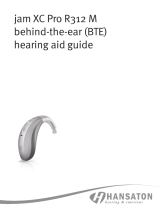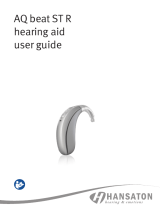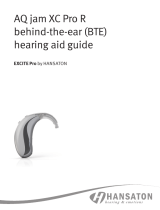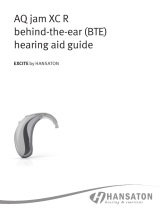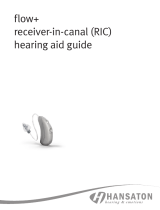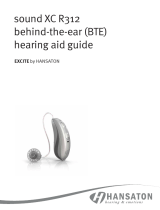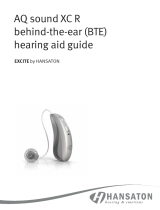Page is loading ...

beat ST RT675 UP
hearing aid
user guide

This user guide applies to the following models:
Hearing aids
beat ST RT UP
beat ST RT UP
beat ST RT UP
beat ST RT UP
beat ST RT UP*
Your hearing aids
Hearing care professional: ____________________
___________________________________________
Telephone: _________________________________
Model: ____________________________________
Serial number: ______________________________
Battery size: 675
Warranty: __________________________________
Program 1 is for: ____________________________
Program 2 is for: ____________________________
Program 3 is for: ____________________________
Program 4 is for: ____________________________
Date of purchase: ____________________________
*Not available in all markets.

Quick reference
2 beeps every
30 minutes
Low battery warning Battery size
675
On/O
Multi-function button
O
On Battery symbol
Changing batteries
Thank you for choosing these hearing aids.
Please read the User guide carefully to make
sure that you understand and get the best out
of your hearing aids. Training is not required
for handling of this device. A hearing care
professional will help setup the hearing aids
to your individual preferences during the sales
consultation.
For more information regarding features,
benets, setup, use and maintenance or repairs
of your hearing aid and accessories – contact
your hearing care professional or manufacturer
representative. Additional information can be
found in the specication sheet of your product.

1. Your hearing aids at a glance ......................................... 2
2. Turning your hearingaids onando .............................. 4
3. Putting your hearing aids on your ears............................ 5
4. Operating instructions .................................................... 6
Battery information ..................................................... 9
Pairing your mobile phone with your hearing aids .....12
Phone calls with a mobile phone .............................. 14
Using your mobile phone with your hearing aids .......15
TV Connector ............................................................. 18
Tinnitus masker ..........................................................19
Flight mode ...............................................................20
5. Caring for your hearing aids ......................................... 22
6. Accessories ................................................................... 27
Assistive listening devices ........................................ 29
7. Troubleshooting guide .................................................. 30
8. Important safety information ........................................ 35
Tinnitus masker ........................................................ 53
9. Operating, transport and storage conditions ............... 56
10. Information and explanation of symbols ..................... 57
11. Compliance information ................................................61
Table of contents

2 3
beat ST RT675 UP BTE hearing aids
2
3
2
4
1
5
6
1. Your hearing aids at a glance
1 Earhook - your custom made earmold attaches to
your hearing aids using the earhook
2 Microphone - sound enters your hearing aids
through the microphones.
3 Multi-function button - switches between
listening programs, changes the volume level,
and accepts or rejects mobile phone calls
depending on your customized tting
4 Battery door (on & o) - close the door to turn on
your hearing aids, open the door all the way to
turn o your hearing aid or to change the battery
5 Tubing - part of the earmold that attaches it to
the earhook
6 Earmold - allows the sound to pass from the
hearing aids to the ear and holds the hearing aids
in place

4 5
3. Putting your hearing aids on your
ears
Your hearing aids will be color-coded with a
marking on the outside of the hearing aid:
red = right ear; blue = le ear.
1. Hold the earmold between
your thumb and index nger,
with the opening facing
toward your ear canal and
the hearing aid resting
above your ear.
2. Carefully insert the earmold
in your ear. You may need
to twist it slightly to the
back. The earmold should
t into your ear snugly and
comfortably. Gently pull
down and back on your
earlobe to help you insert
the earmold into your ear
canal more easily.
3. Place the hearing aid over
the top of your ear.
1.
2.
3.
2. Turning your hearingaids
onando
The battery door acts as an on and o switch.
1. On: Close the battery door
fully.
Note: It may take 5 seconds
before the hearing aid turns
on. Your hearing healthcare
provider can additionally
increase the start up delay if
required.
2. O: Partially open the
battery door.
3. Open: Fully open the battery
door to access and change
the battery.
Note: When turning your hearing aid on and o
while it is on the ear, grasp the top and bottom
of the device with your index nger and thumb.
Use your thumb to open and close the battery
door.
2.
1.

6 7
Program control
Each time you push the upper part of the button
on either hearing aid for longer than 2 seconds,
you will move to the next hearing aid program.
Your hearing aids beep to indicate which
program you are in.
Program setting Beeps
Program 1 (e.g. automatic program) 1 beep
Program 2 (e.g. speech in noise) 2 beeps
Program 3 (e.g. telephone) 3 beeps
Program 4 (e.g. music) 4 beeps
Please see the front of this booklet for a listing
of your personalized programs.
4. Operating instructions
Your hearing aids come with a multi-function
button that allows you to further adjust them.
You may also use the multi-function button
to accept and reject calls to your paired
mobile phone. You may also use the optional
RemoteControl or stream remote App to
control your hearing aids.
These instructions describe the default
multi-function button settings. Your hearing
care professional may change the functionality
of the buttons. See your hearing care
professional for more information.
Multi-function button
The multi-function button on your
hearing aids can be both a volume
control and a program control.

8 9
Battery information
Low battery warning
Two long beeps indicate the hearing aid battery
is low. Aer the low battery warning, sounds
may not be as clear. This is normal and can be
xed by changing the batteries.
If you can’t hear the low battery warning, your
hearing healthcare professional can change its
pitch or loudness. If you prefer, it can be turned
o entirely.
Your hearing aids are designed to generate a
low battery warning every 30 minutes until you
change the batteries, but depending on the
condition of the batteries, they may die before
another low battery warning occurs. Therefore,
it is recommended that the batteries are
replaced as soon as possible once you hear the
low battery warning.
Volume control
To adjust the volume of your environment:
• Push the upper part of the button on the
hearing aid to increase the volume, and
• Push the lower part of the button on the
hearing aid to decrease the volume
As you change the volume, your hearing aids
will beep.
Volume setting Beeps
Suggested volume level 1 beep
Turning volume up short beep
Turning volume down short beep
Maximum volume level 2 beeps
Minimum volume level 2 beeps

10 11
Caring for batteries
• Always discard batteries in a safe and
environmentally friendly way.
• To prolong battery life, remember to turn your
hearing aids o when not in use, especially
when asleep.
• Remove the batteries and keep the battery
door open while hearing aids are not being
worn, especially when asleep. This will allow
internal moisture to evaporate.
Replacing the battery
1. Gently swing out the battery
door with your ngernail.
2. Grasp the battery with your
thumb and index nger and
remove.
3. Insert the new battery into the
battery compartment with the
plus (+) sign on the battery
facing the same way as the
plus (+) sign on the side of the
battery door. This will ensure
that the battery door closes
properly.
Note: If the battery is inserted
incorrectly, the hearing aid will
not turn on.
4. Close the battery door.
1.
2.
3.
4.

12 13
Connecting to your mobile phone
Aer your hearing aids have been paired to
your phone, they will automatically connect
again when your phone and hearing aids are
turned on and in range. This can take up to
2minutes.
The connection will be maintained as long as
the phone remains ON and within a range of
up to 10 m (30 ).
To switch a call between your hearing aids
and the speaker on your mobile phone, select
the audio source you would like from your
phone. If you are not sure how to do this,
consult the instruction manual that came
with your mobile phone.
Bluetooth® is a registered trademark owned by the Bluetooth SIG, Inc.
Pairing your mobile phone with your
hearing aids
1. On your phone, go to your settings menu
to ensure Bluetooth® is on and
to search for Bluetooth enabled
devices.
2. Turn your hearing aids on by
closing the battery door. Your
hearing aids will remain in pairing mode for
minutes.
3. Your phone will show a list of found
Bluetooth enabled devices. Select your
hearing aid from the list to simultaneously
pair both hearing aids. You will hear
a melody when your phone has been
successfully paired to your hearing aids.
It is only necessary to perform the pairing
procedure once with each Bluetooth enabled
phone.
Consult your phone user guide for instructions
on pairing a Bluetooth device with your phone.

14 15
Using your mobile phone with your
hearing aids
Making a phone call
Start a call on your paired mobile phone as you
normally would. You will hear the audio through
your hearing aids. Your hearing aids pick up
your voice through their own microphones.
Accepting a mobile phone call
When receiving a call, an incoming call
notication will be heard in the hearing aids.
The call can be accepted by a short push of
less than 2 seconds on either the upper or
lower part of the button on either hearing aid.
Alternatively, accept the call on your phone as
you normally would.
short push
< 2 sec
Phone calls with a mobile phone
Your hearing aids allow direct communication
with Bluetooth enabled phones. When paired
and connected to a phone, you will hear the
caller’s voice directly in your hearing aids. Your
hearing aids pick up your voice through their own
microphones. Two active Bluetooth devices such
as a phone can be connected to your hearing aids,
with support for additional pairings.
You do not need to hold your mobile phone close
to your mouth, your voice is transmitted through
the hearing aids to your mobile phone.
Caller’s voice
Your voice

16 17
Adjusting volume balance between mobile
phone calls and your environment
During a call using a paired mobile phone:
• Push the upper part of the hearing aid
button to increase the call volume and
decrease the volume of sounds in your
environment
• Push the lower part of the hearing aid
button to decrease the call volume and
increase the volume of sounds in your
environment
Call volume up
Call volume down
Ending a phone call
End a call by holding down the upper or lower
part of the button on either hearing aid for more
than 2 seconds. Alternatively, end the call on
your phone as you normally would.
Rejecting a phone call
An incoming call can be rejected by holding
down the upper or lower part of the button
on either hearing aid for more than 2 seconds.
Alternatively, reject the call on your phone as
you normally would.
long push
> 2 sec

18 19
Tinnitus masker
If your hearing care professional has congured
a tinnitus masker program, you can adjust
the tinnitus masker level while you are in the
tinnitus masker program. To adjust the noise
level:
• Push the upper part of the hearing aid
button to increase the tinnitus masker, and
• Push the lower part of the hearing aid
button to decrease the tinnitus masker
stream remote App:
• Tap the advanced features button where
you can adjust the tinnitus masker volume
up or down
As you change the level, your hearing aids will
beep.
TV Connector
Adjusting volume balance between the TV and
the sounds in your environment
While listening to TV sound through the
TV Connector accessory:
• Push the upper part of the hearing aid
button to increase the TV volume and
decrease the volume of sounds in your
environment
• Push the lower part of the hearing aid
button to decrease the TV volume and
increase the volume of sounds in your
environment
TV volume down
TV volume up

20 21
Exiting flight mode
To enable the Bluetooth wireless function and
to exit flight mode:
1. Open the battery door.
2. Close the battery door.
1.
2.
Flight mode
Your hearing aids operate in the frequency
range of . GHz–.8 GHz. When flying, some
airlines require all devices to be switched into
flight mode. Entering flight mode will not disable
normal hearing aid functionality, only the
Bluetooth connectivity functions.
Entering flight mode
To disable the Bluetooth
wireless function and enter
flight mode:
1. Open the battery door.
2. With the hearing aid turned
o, hold down the lower
push button on the
hearing aid while closing
the battery door, and
keep the button pushed
down for seconds.
2.
1.

22 23
• Protect your hearing aids from excessive heat
(hair dryer, vehicle glove box or dashboard).
• Ensure you do not twist or squeeze the wires
when your hearing aids are placed in their
case.
• Regular use of a dehumidier, such as a
Clean Dry kit, can help prevent corrosion and
prolong the life of your hearing aids. Remove
batteries before using a dehumidier.
• Do not drop your hearing aids or knock them
against hard surfaces.
5. Caring for your hearing aids
Protecting your hearing aids
• Diligent and routine care of your hearing aids
contribute to outstanding performance and
a long service life. To ensure a long service
life, Sonova AG provides a minimum of a ve
year service period aer phase out of the
respective hearing aid.
• Open the battery doors when not in use.
• Always remove your hearing aids when
using hair care products. The hearing aids
can become clogged and cease to function
properly.
• Do not wear your hearing aids in the bath or
shower or immerse them in water.
• If your hearing aids do become wet, do not
attempt to dry them in an oven or microwave.
Do not adjust any controls. Open the battery
doors immediately, remove the batteries and
allow your hearing aids to dry naturally for
24hours.

24 25
Cleaning your earmolds
Clean the earmold and the
outside of the earhook with
a damp cloth at the end of
each day. Avoid getting any
water in the hearing aids.
Do not use alcohol to clean your earmolds.
If the earmolds become plugged, clear the
opening with a wax loop or pipe cleaner.
If your physician prescribes eardrops, clean
any moisture that may get into the earmolds or
tubing to prevent plugging.
Cleaning your hearing aids
Use a so cloth to clean your hearing aids at
the end of each day. Regular cleaning of the
microphone ports with the supplied cleaning
brush will ensure that your hearing aids will
maintain their sound quality. Your hearing care
professional can demonstrate this for you.
Place the hearing aids in the case overnight
with the battery doors open to allow moisture
to evaporate.
Ear wax is natural and common. Ensuring your
hearing aids are free of ear wax is an important
step in your daily cleaning and maintenance
routine.
Never use alcohol to clean your hearing aids,
earmolds or domes.
Do not use sharp tools to dislodge ear wax.
Sticking household items into your hearing aids
or earmolds can seriously damage them.

26 27
6. Accessories
TV Connector
The TV Connector is an optional accessory
that sends sound from your TV directly to
your hearing aids. The TV Connector can also
transmit sound from stereo systems, computers
and other audio sources.
Remote Control
The Remote Control is an optional accessory
that can be used to control volume level and
program changes of the hearing aid.
PartnerMic
The PartnerMic is an optional accessory that
can be used to stream a speaker’s voice
wirelessly to your hearing aids
RogerDirectTM
Your hearing aids are compatible with RogerTM
accessories. Roger accessories can be used to
transmit a voice or sound source wirelessly to
your hearing aids
If the earmolds require further cleaning:
1. Disconnect the plastic tube from the hook of
the hearing aid, by holding the hearing aid in
one hand and gently pulling the tubing away
from the earhook.
2. Wash only the earmolds and tubing in warm
water with a mild soap.
3. Rinse them with cool water and dry
overnight.
4. Make sure the earmold tubes are completely
dry. Reconnect them to the earhook on your
hearing aid by sliding the tubing back on
to the earhook. Use of a hearing aid blower
can assist with removing moisture/debris
from the tube. See your hearing healthcare
professional for more information.

28 29
Assistive listening devices
Listening in public places
Telecoils pick up electromagnetic energy and
convert it into sound. Your hearing aid’s telecoil
option can help you listen in public places
equipped with telecoil compatible
assistive listening devices such as a
loop system.
When you see this symbol, a loop system
is present and it is compatible with your
hearing aid. Please contact your hearing care
professional for more information on loop
systems.
Connectivity overview
The illustration below shows the connectivity
options available for your hearing aids.
Please see the user guide that came with your
accessory for more information. Please contact
your hearing care professional to get a
TV Connector, Remote Control, PartnerMic or
Roger accessories.
Mobile phone
TV
Connector
connected
to TV
PartnerMic

30 31
Cause Possible remedy
Issue: Not loud enough
Low volume Turn up volume; see hearing
healthcare professional if
problem persists
Low battery Replace battery
Earmolds not inserted
properly
See “3. Putting your hearing
aids on your ears”. Reinsert
carefully
Change in hearing Consult your hearing care
professional
Earmolds blocked with
ear wax
Clean earmolds. See
“Cleaning your hearing
aids”. Consult your hearing
care professional
Plugged microphone
shield
Consult your hearing care
professional
Cause Possible remedy
Issue: No sound
Not turned on Turn on
Low/dead battery Replace battery
Poor battery contact Consult your hearing care
professional
Battery upside down Insert battery plus (+) side
up
Earmolds/power slim
tubes blocked with ear
wax
Clean earmolds. See
“Cleaning your hearing
aids”. Consult your hearing
care professional
Plugged microphone
shield
Consult your hearing care
professional
7. Troubleshooting guide

32 33
Cause Possible remedy
Issue: Not clear, distorted
Poorly tting earmolds Consult your hearing care
professional
Earmolds blocked with
ear wax
Clean earmolds. See
“Cleaning your hearing
aids”. Consult your hearing
care professional
Low battery Replace battery
Plugged microphone
shield
Consult your hearing care
professional
Issue: Earmolds falling out of ear
Poorly tting earmolds Consult your hearing care
professional
Earmolds not inserted
properly
See “3. Putting your hearing
aids on your ears”. Reinsert
carefully
Cause Possible remedy
Issue: Intermittent
Low battery Replace battery
Dirty battery contact Consult your hearing care
professional
Issue: Two long beeps
Low battery Replace battery
Issue: Whistling
Earmolds not inserted
properly
See “3. Putting your hearing
aids on your ears”. Reinsert
carefully
Hand/clothing near ear Move hand/clothing away
from your ear
Poorly tting earmolds Consult your hearing care
professional
/
